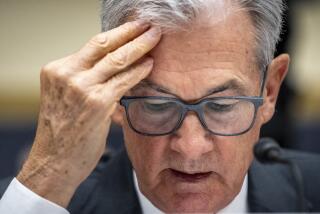A noncommittal Fed
- Share via
TALK ABOUT IRRATIONAL EXUBERANCE. Stock markets surged Thursday because of what the Federal Reserve didn’t say.
As expected, the central bank raised its short-term interest rate a quarter-point, the 17th consecutive hike since mid-2004. The Federal Open Market Committee explained that although economic growth was slowing, other factors “have the potential to sustain inflation pressures.” With customary ambiguity, the committee said its next moves would depend on how the outlook for economic growth and inflation evolved.
The Fed’s statement was simply a variation of “That depends,” a time-honored, noncommittal answer to practically any question about the future. Still, it was notably different from the news release that followed the committee’s previous meeting on May 10. Then, the Fed explicitly warned that more interest-rate hikes might be needed.
The contrasting levels of noncommitment sparked the largest daily run-up in the Dow Jones Industrial Average since March 2003. Then, on Friday, the Commerce Department reported slower growth in consumer spending and a steadying rate of inflation, which could relieve pressure for more rate hikes.
All the recent volatility and confusion about discerning the Fed’s real intentions should lead Chairman Ben S. Bernanke to forge ahead with one of his long-standing pet ideas: having the Fed publicly set a target for inflation. The Fed’s governors have an informal comfort range of 1% to 2% for “core” inflation, the index that excludes volatile energy and food prices. Before joining the board, Bernanke argued that the Fed should publicly declare a target for inflation and focus on keeping inflation within that range. Doing so would set people’s expectation of inflation, which would in turn reduce the pressure to raise wages and prices, according to Bernanke and other proponents of public targets. It’s an approach taken by about two dozen central banks around the world.
Public inflation targets would be a natural extension of the Fed’s slow, steady drive toward transparency. Alan Greenspan started the process by ending the Fed’s Wizard-of-Oz habit of hiding its deliberations behind a curtain of confidentiality. Bernanke has continued the trend, in part by making notably less oblique pronouncements than Greenspan. Having a clear target would further enhance the Fed’s predictability.
More to Read
Inside the business of entertainment
The Wide Shot brings you news, analysis and insights on everything from streaming wars to production — and what it all means for the future.
You may occasionally receive promotional content from the Los Angeles Times.









